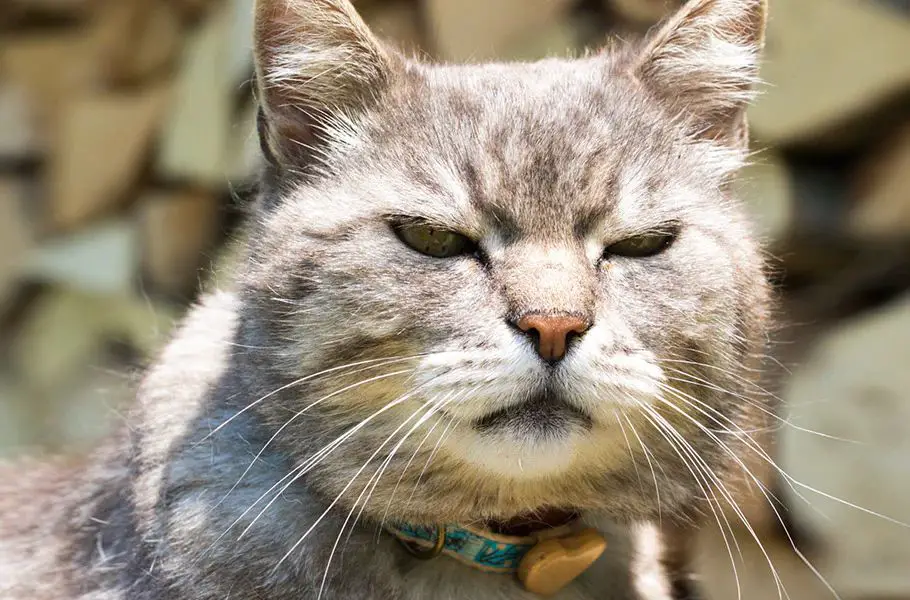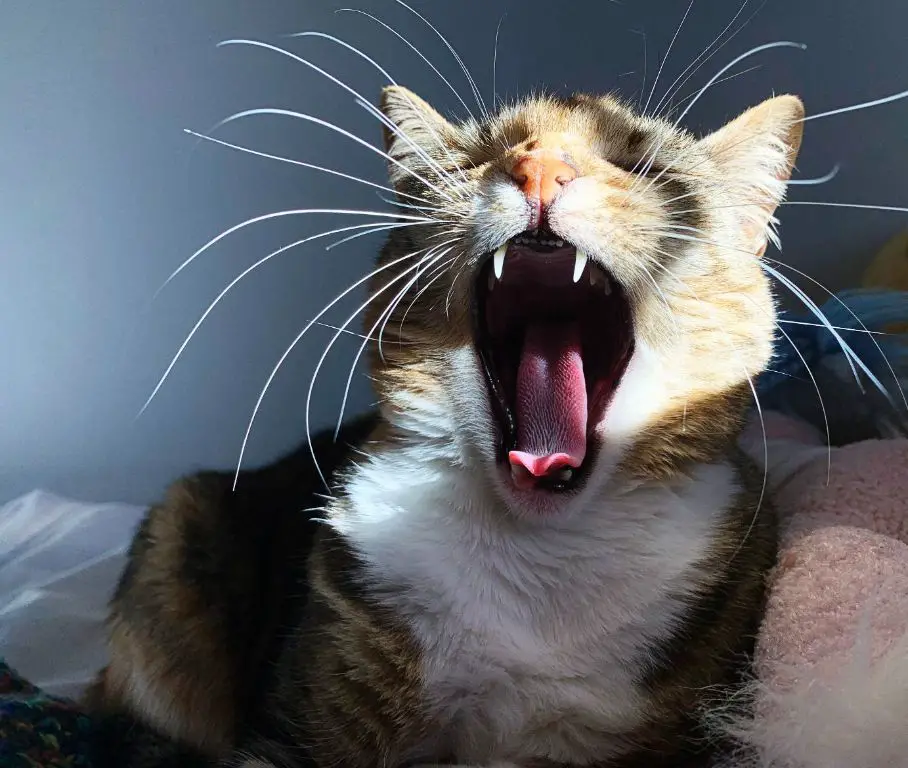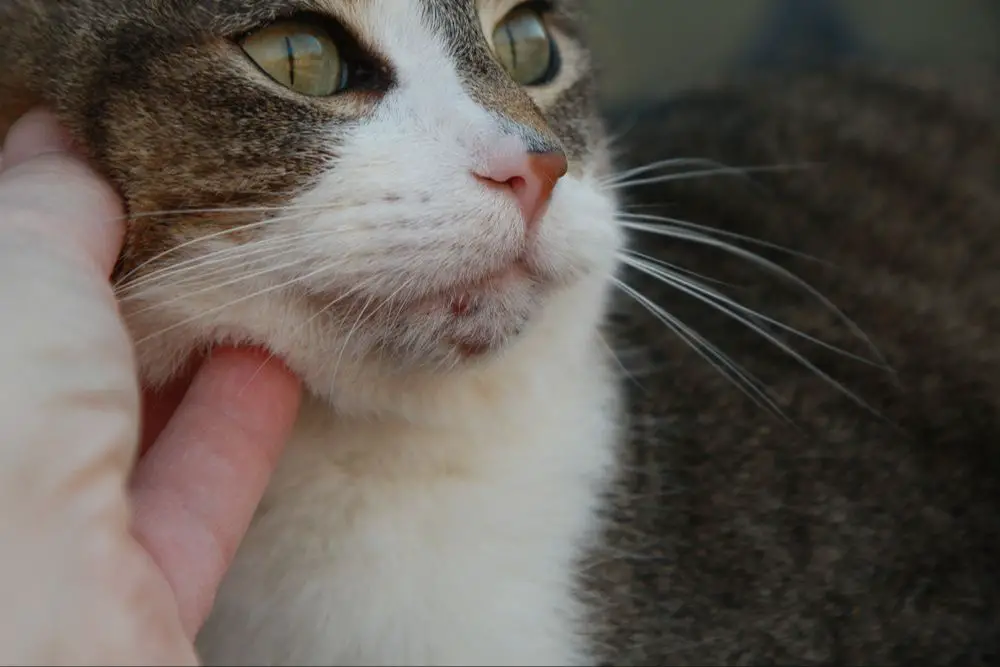What Are Cat Whiskers?
Cat whiskers, also known as vibrissae, are thick, specialized hairs that protrude from a cat’s upper lip, cheeks, chin and above their eyes. Whiskers serve important sensory functions and help cats perceive the world around them.
Cats have approximately 12 whiskers on each side of their face. Their whiskers are highly sensitive tactile hairs, with nerves that connect them directly to a cat’s somatosensory cortex in the brain. Whiskers send neural sensory messages to a cat about the position, shape and 3D space around objects near their head. This allows them to identify openings for hunting, judge if they can fit their body through spaces, and detect air currents (Source). Whiskers essentially act like mini antennae around a cat’s face, aiding vision in low light and providing spatial awareness.
Whiskers also help cats maintain balance while moving at high speeds when hunting prey. They can point their whiskers forward to avoid obstacles and judge distances as they run and pounce. Overall, whiskers give cats key sensory information about their surroundings that they rely on for hunting, navigation and everyday functioning.
Do Cat Whiskers Fall Out?

It is completely normal for cats to shed their whiskers. Just like human hair and fur, a cat’s whiskers go through a natural growth cycle. Old whiskers will eventually fall out as new ones grow in to replace them. This shedding and regrowth allows the whisker follicles to remain healthy.
Whiskers typically last for several months before shedding. Most cats will lose a few whiskers per week, which often go unnoticed. The loss of a few whiskers at a time is not a cause for concern. Excessive loss of multiple whiskers simultaneously could indicate an underlying issue.
Overall, minor whisker loss is a routine part of a cat’s body processes. As long as new whiskers are growing in, there is no need to worry. However, abnormal or asymmetric shedding should be evaluated by a veterinarian.
Citations:
https://thevillagevets.com/blog/cat-whiskers/
https://wagwalking.com/wellness/why-do-my-cats-whiskers-fall-out
What Causes Cat Whiskers To Fall Out?
Cat whiskers naturally fall out and regrow as part of their normal growth cycles. Like human hair, cat whiskers go through a growth, rest, and shedding phase. It’s normal for some whiskers to shed every few months as new ones push out and replace them. This natural shedding and regrowth should not cause any issues for cats.
However, excessive or abnormal whisker loss can be caused by injuries, stress, or illnesses. Cats can lose whiskers due to inflammatory skin diseases, allergies, infections, hormone imbalances, and other medical conditions affecting the skin and hair follicles around the muzzle. Severe stress and anxiety, such as from changes in environment or social conflicts, may also lead to whisker loss. Physical trauma like burns, scrapes, or parasites can damage the delicate whisker follicles. If a cat seems to be losing whiskers rapidly and unevenly, it’s a good idea to see a vet to identify and treat any underlying cause.

According to veterinarians, it’s rare for whisker loss alone to indicate a serious medical issue (https://wagwalking.com/wellness/why-do-my-cats-whiskers-fall-out). But abnormal shedding, especially when accompanied by other symptoms, can be a clue to look out for. Pay attention to any changes in your cat’s health, behavior, or appearance that occur along with whisker loss.
Signs Of Abnormal Whisker Loss
Some signs that your cat is experiencing abnormal whisker loss include:
- Patches of missing whiskers – Your cat may have bald patches where whiskers are completely gone. This is not normal shedding.
- Rapid, excessive whisker loss – Healthy cats shed just a few whiskers at a time. If you notice many whiskers falling out daily, it could signal an issue.
- Kitten whisker loss – Kittens younger than 8 weeks should not be losing whiskers. Loss at this age likely indicates an underlying problem.
Cats rely on their whiskers for spatial awareness and sensing stimuli in their environment. Abnormal loss can negatively impact these functions. Pay attention to any sudden or patchy whisker shedding, as it may require veterinary attention. For more on diagnosing the causes, see the WagWalking and Canidae articles.
Diseases That Cause Whisker Loss
There are several diseases that can lead to abnormal whisker loss in cats:

Hyperthyroidism – An overactive thyroid gland speeds up metabolism, which can cause hair loss and shedding, including whiskers. Other symptoms include weight loss, increased appetite, vomiting, and hyperactivity.[1]
Cancer – Feline squamous cell carcinoma is a type of skin cancer that can develop on the nose and face, leading to whisker loss. It may appear as reddened skin lesions or scabs in the area.[2]
Ringworm – A fungal skin infection that causes circular bald patches. The whiskers often fall out in the affected areas. Other signs include crusting, scales, and itchiness.
Feline Leukemia – A viral disease that suppresses the immune system and can result in secondary infections causing whisker loss and shedding.
If an underlying illness is suspected, the vet will run tests like bloodwork, biopsies, and skin scrapings to diagnose the condition and determine appropriate treatment.
Other Causes of Excessive Shedding
Some other causes of excessive whisker loss in cats include:
Stress – Cats can shed more whiskers than normal when stressed. Stressors like changes in environment, new people or animals, loud noises, etc. can cause cats to overgroom and pull out whiskers. According to WagWalking, many cats shed excessively when stressed, and you’ll notice changes in their coat’s shine and texture as well [1].
Trauma – Injuries to a cat’s face and head from accidents or fighting with other animals can cause whiskers to break or fall out. The whiskers don’t always grow back in the same pattern.
Malnutrition – Cats with diets deficient in nutrients like proteins, fatty acids, and vitamins may have excessive whisker loss along with a dull coat. This is reversible with dietary improvements.
Allergies – Allergies, especially to foods or flea bites, can cause inflammation and itchiness leading cats to excessively groom and pull out whiskers. Managing allergies can help reduce shedding.
When To See The Vet
You should consider taking your cat to see the veterinarian if their whisker loss seems excessive or abnormal. Rapid whisker shedding that leaves bald patches is not normal and could signal an underlying medical issue (https://thevillagevets.com/blog/cat-whiskers/).

It’s also advisable to schedule a vet visit if your cat’s whisker loss is accompanied by other symptoms like appetite changes, lethargy, weight loss, skin irritation, or behavioral changes. These associated symptoms could point to a more serious health problem that requires veterinary attention and treatment.
Some examples of diseases that can cause abnormal whisker loss include hyperthyroidism, kidney disease, diabetes, cancer, and dental infections. Your vet can run tests to check for these and other conditions. It’s important to identify and address the underlying cause of your cat’s whisker shedding.
In summary, contact your veterinarian promptly if your cat is rapidly losing whiskers or if the whisker loss is paired with other signs of illness. This will allow for timely diagnosis and care for your cat.
How To Help Cat Whisker Regrowth
There are a few tips that can help promote healthy whisker regrowth in cats:
Reduce Stress and Trauma – Cats who have experienced stress or trauma that led to whisker loss will need a calm, comforting environment to help new whiskers grow back. Keep their routine consistent, allow them safe spaces to hide if needed, and use pheromone diffusers or calming treats to ease anxiety. Reducing stress helps the body focus energy on regrowth.
Provide Proper Nutrition – Eating a nutritious diet with high-quality protein is essential for cats to regrow whiskers. According to the Waggel blog, vitamins like biotin and methylsulfonylmethane (MSM) also support healthy whisker follicles. Talk to your vet about supplements if needed.
Be Patient – It takes 2-3 months on average for new whiskers to fully regrow. Avoid handling or disturbing the whisker area unnecessarily while they grow back in.
Overall, minimizing stress, maximizing nutrition, and being patient will help whiskers return to their normal splendor.
Caring For A Cat With Missing Whiskers
If your cat is missing some or all of its whiskers, there are a few things you can do to help it adjust and navigate its surroundings:
Cats rely on their whiskers to gauge if they can fit through small spaces. With missing whiskers, they may bump into things more often. Provide clear pathways through your home without narrow passages to help them get around.
Whiskers detect air currents and movement. Your cat may have trouble hunting or playing without this sensory input. Consider hand feeding them more often and use toys on strings so they can follow the movement.
Trim overgrown claws. With no whiskers to detect objects, claws can get caught more easily on carpets and fabrics. Keeping claws trimmed prevents injuries.
Check food and water location. Cats use their whiskers to find dishes when eating and drinking. Place these in easy to find areas within their routine paths.
Patience and time will allow your cat to adapt to missing whiskers. Provide extra love and care while their whiskers regrow. Monitor them closely to ensure they are navigating comfortably.
Key Takeaways
Overall, some cat whisker shedding is normal as they grow in cycles like hair. But excessive loss or thinning whiskers can signal potentially serious health issues. Monitoring your cat’s whiskers can help alert you to problems early.
The key points to remember are:
- Cat whiskers grow in cycles and naturally fall out and regrow over time.
- Missing whiskers affect cats’ spatial awareness and ability to judge distances.
- Diseases, stress, old age, trauma, and other factors can cause abnormal whisker loss.
- Take note if your cat is shedding whiskers excessively or seems imbalanced.
- See your vet promptly if your cat has thinning whiskers or seems disoriented.
- With treatment for any underlying issue, whiskers can potentially regrow over time.
While a certain amount of natural shedding happens, significant whisker loss often signals bigger health issues. So be attentive to any changes in your cat’s whiskers.
